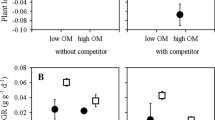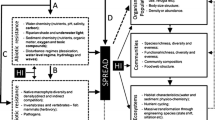Abstract
Hydrilla verticillata is a submerged, rooted macrophyte native to Asia and Australia, but currently attains broad distribution across all continents. Its success as an invasive species depends on the simultaneous influence of abiotic and biotic factors on different components of its performance. We conducted a factorial experiment to test the short-term responses of Hydrilla, present since 2005 in the upper Parana River (Brazil), to a native herbivore (apple snail Pomacea canaliculata) and increased water temperature, using two different spatial arrangements of macrophyte fragments (one simulating early establishment phase and other simulating late establishment phase). Temperature, herbivory and plant spatial arrangement individually, and in some cases through their interactions, caused changes in the growth likely indicating impacts for the ecological responses of Hydrilla´s establishment. Snail herbivory decreased plant growth thus exerting biotic resistance, while higher temperature increased Hydrilla´s invasiveness. According to our results and other pieces of evidence, invasions of Hydrilla might worsen under the future climate warming scenario, but herbivores might locally mitigate invasion speed or magnitude.

Similar content being viewed by others
References
Alofs KM, Jackson DA (2014) Meta-analysis suggests biotic resistance in freshwater environments is driven by consumption rather than competition. Ecology 95:3259–3270
Barrat-Segretain MH, Gudrun B, Hering-Vilas-Bôas A (1998) Comparative abilities of vegetative regeneration among aquatic plants growing in disturbed habitats. Aquat Bot 60:201–211
Blackburn TM, Pyšek P, Bacher S, Carlton JT, Duncan RP, Jarošik V, Wilson JRU, Richardson DM (2011) A proposed unified framework for biological invasions. Trends Ecol Evol 26:333–339
Carlsson NOL, Brönmark C, Hansson LA (2004) Invading herbivory: the golden apple snail alters ecosystem functioning in Asian wetlands. Ecology 85:1575–1580
Chadwell TB, Engelhardt KAM (2008) Effects of pre-existing submersed vegetation and propagule pressure on the invasion success of Hydrilla verticillata. J Appl Ecol 45:515–523
Coetzee JA, Hill MP (2012) The role of eutrophication in the biological control of water hyacinth, Eichhornia crassipes, in South Africa. Biocontrol 57:247–261
Cook CDK, Lüönd R (1982) A revision of the genus Hydrilla (Hydrocharitaceae). Aquat Bot 13:485–504
Cruz C, Silva AF, Venturini FP, Garlich N, Pitelli RLCM, Pitelli RA (2015) Food preference and consumption of aquatic macrophytes submerged by snail Pomacea canaliculata. Planta Daninha 33:433–439
Cuda JP, Coon BR, Dao YM, Center TD (2011) Effect of an herbivorous stem-mining midge on the growth of Hydrilla. J Aquat Plant Manag 49:83–89
Dong B-C, Yu G-L, Guo W, Zhang M-X, Dong M, Yu F-H (2010) How internode length, position and presence of leaves affect survival and growth of Alternanthera philoxeroides after fragmentation? Evol Ecol 24:1447–1461
Fleming JP, Dibble ED (2015) Ecological mechanisms of invasion success in aquatic macrophytes. Hydrobiologia 746:23–37
Hahn PG, Orrock JL (2015) Spatial arrangement of canopy structure and land use history alter the effect that herbivores have on plant growth. Ecosphere 6:1–16
Heiler KCM, von Oheimb PV, Ekschmitt K, Albrecht C (2008) Studies on the temperature dependence of activity and on the diurnal activity rhythm of the invasive Pomacea canaliculata (Gastropoda: Ampullariidae). Mollusca 26:73–81
Hofstra DE, Clayton J, Green JD, Auger M (1999) Competitive performance of Hydrilla verticillata in New Zealand. Aquat Bot 63:305–324
Jiang J, Kong F, Gu X, Chen K, Zhao S, Wang J (2010) Influence of intraspecific interaction and substrate type on initial growth and establishment of Hydrilla verticillata. Hydrobiologia 649:255–265
Langeland KA (1996) Hydrilla verticillata (L. F.) Royle (Hydrocharitaceae), “The perfect aquatic weed”. Castanea 61:293–304
Lemoine NP, Burkepile DE, Parker JD (2014) Variable effects of temperature on insect herbivory. Peer J 2:e376
Li Z, He L, Zhang H, Urrutia-Cordero P, Ekvall MK, Hollander J, Hansson L-A (2017) Climate warming and heat waves affect reproductive strategies and interactions between submerged macrophytes. Glob Change Biol 23:108–116
Lin H-F, Alpert P, Yu F-H (2012) Effects of fragment size and water depth on performance of stem fragments of the invasive, amphibious, clonal plant Ipomoea aquatica. Aquat Bot 99:34–40
Luque GM, Bellard C, Bertelsmeier C, Bonnaud E, Genovesi P, Simberloff D, Courchamp F (2014) The 100th of the world’s worst invasive alien species. Biol Invasions 16:981–985
Madsen JD, Owens CS (2000) Factors contributing to the spread of Hydrilla in lakes and reservoirs. Aquatic plant control technical notes collection (ERDC TN-APCRP-EA-01). US Army Engineer Research and Development Center, Vicksburg, pp 1–11
Madsen JD, Smith DH (1999) Vegetative spread of dioecious Hydrilla colonies in experimental ponds. J Aquat Plant Manag 37:25–29
Marengo JA, Ambrizzi T, da Rocha RP, Alves LM, Cuadra SV, Valverde MC, Torres RR, Santos DC, Ferraz SET (2010) Future change of climate in South America in the late twenty-first century: intercomparison of scenarios from three regional climate models. Clim Dyn 35:1073–1097
McKee D, Hatton K, Eaton JW, Atkinson D, Atherton A, Harvey I, Moss B (2002) Effects of simulated climate warming on macrophytes in freshwater microcosm communities. Aquat Bot 74:71–83
Mony C, Koschnick TJ, Haller WT, Muller S (2007) Competition between two invasive Hydrocharitaceae (Hydrilla verticillata (L.f.) (Royle) and Egeria densa (Planch)) as influenced by sediment fertility and season. Aquat Bot 86:236–242
O´Connor MI (2009) Warming strengthens an herbivore-plant interaction. Ecology 90:388–398
Owens CS, Grodowitz MJ, Smart RM, Harms NE, Nachtrieb JM (2006) Viability of Hydrilla fragments exposed to different levels of insect herbivory. J Aquat Plant Manag 44:145–147
Owens CS, Smart RM, Dick GO (2008) Resistance of Vallisneria to invasion from Hydrilla fragments. J Aquat Plant Manag 46:113–116
P´yankov VI, Ivanov LA (2000) Biomass allocation in boreal plants with different ecological strategies. Russ J Ecol 31:1–7
Pesacreta GJ (1990) Aquatic plant control research program: pilot study: carbohydrate allocation in Hydrilla biotypes. No. WES/MP/A-90-2. Environmental Lab, Army Engineer Waterways Experiment Station, Vicksburg
Pieczynska E (2003) Effect of damage by the snail Lymnaea (Lymnaea) stagnalis (L.) on the growth of Elodea canadensis Michx. Aquat Bot 75:137–145
Ribas LGS, Cunha ER, Vitule JRS, Mormul RP, Thomaz SM, Padial AA (2017) Biotic resistance by snails and fish to an exotic invasive aquatic plant. Fresh Biol 62:1266–1275
Riis T, Sand-Jensen K (2006) Dispersal of plant fragments in small streams. Freshw Biol 51:274–286
Roberts DA, Poore AGB (2006) Habitat configuration affects colonization of epifauna in a marine algal bed. Biol Conserv 127:18–26
Silveira MJ, Thomaz SM, Mormul RP, Pereira F (2009) Effects of desiccation and sediment type on early regeneration of plant fragment of three species of aquatic macrophyte. Intern Rev Hydrobiol 94:169–178
Sousa WTZ (2011) Hydrilla verticillata (Hydrocharitaceae), a recent invader threatening Brazil´s freshwater environments: a review of the extent of the problem. Hydrobiologia 669:1–20
Sousa WTZ, Thomaz SM, Murphy KJ (2010) Response of native Egeria najas Planch. and invasive Hydrilla verticillata (L.f.) Royle to altered hydroecological regime in a subtropical river. Aquat Bot 92:40–48
Strayer D (2010) Alien species in fresh waters: ecological effects, interactions with other stressors, and prospects for the future. Freshw Biol 55:152–174
Thiébaut G, Martinez L (2015) An exotic macrophyte bed may facilitate the anchorage of exotic propagules during the first stage of invasion. Hydrobiologia 746:183–196
Umetsu CA, Evangelista HBA, Thomaz SM (2012) The colonization, regeneration, and growth rates of macrophytes from fragments: a comparison between exotic and native submerged aquatic species. Aquat Ecol 46:443–449
Underwood AJ (1997) Experiments in ecology: their logical design and interpretation using analysis of variance. University Press, Cambridge, p 504
Wang J-W, Yu D, Xiong W, Han Y-Q (2008) Above- and belowground competition between two submersed macrophytes. Hydrobiologia 607:113–122
Wu J, Cheng S, Liang W, Wu Z (2009) Effects of organic-rich sediment and below-ground sulfide exposure on submerged macrophyte, Hydrilla verticillata. Bull Environ Contam Toxicol 83:497–501
Yu H, Ye C, Song X, Liu J (2010) Comparative analysis of growth and physio-biochemical responses of Hydrilla verticillata to different sediments in freshwater microcosms. Ecol Eng 36:1285–1289
Yvon-Durocher G, Montoya JM, Trimmer M, Woodward G (2011) Warming alters the size spectrum and shifts the distribution of biomass in aquatic ecosystems. Global Change Biol 17:1681–1694
Acknowledgements
Clementina Calvo acknowledges the Agencia Nacional de Investigación e Innovación (ANII, Uruguay) for funding her MSc. We are also grateful to the State University of Maringá (UEM, Brazil) for supplies and facilities provided to perform the experiment. Mariana Meerhoff thanks the support of ANII and PEDECIBA. Roger P. Mormul and Sidinei M. Thomaz acknowledge the National Council for Scientific and Technological Development (CNPq) for providing continuous funding through a Scientific Productivity grant.
Author information
Authors and Affiliations
Corresponding author
Electronic supplementary material
Below is the link to the electronic supplementary material.
Rights and permissions
About this article
Cite this article
Calvo, C., Mormul, R.P., Figueiredo, B.R.S. et al. Herbivory can mitigate, but not counteract, the positive effects of warming on the establishment of the invasive macrophyte Hydrilla verticillata. Biol Invasions 21, 59–66 (2019). https://doi.org/10.1007/s10530-018-1803-3
Received:
Accepted:
Published:
Issue Date:
DOI: https://doi.org/10.1007/s10530-018-1803-3




